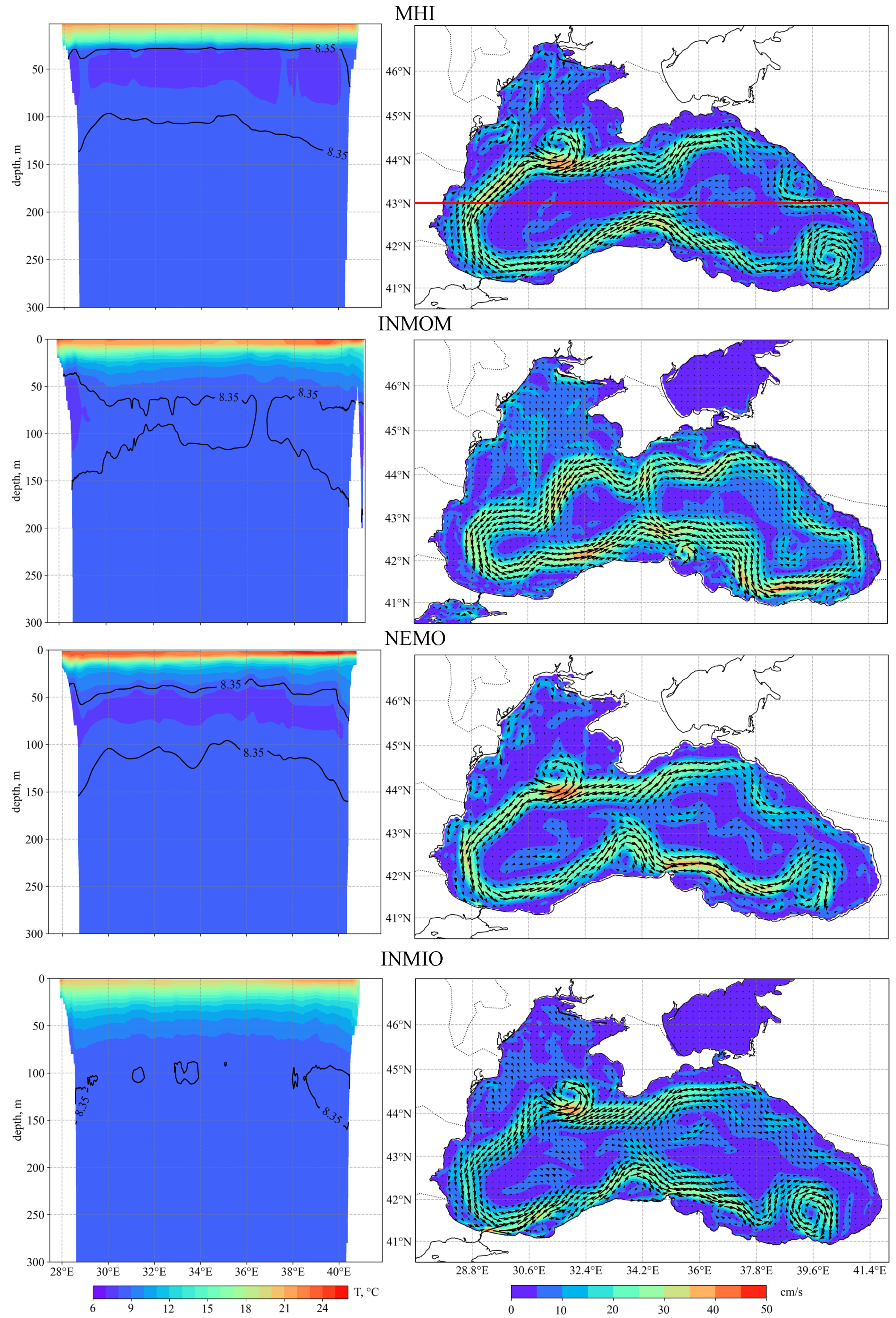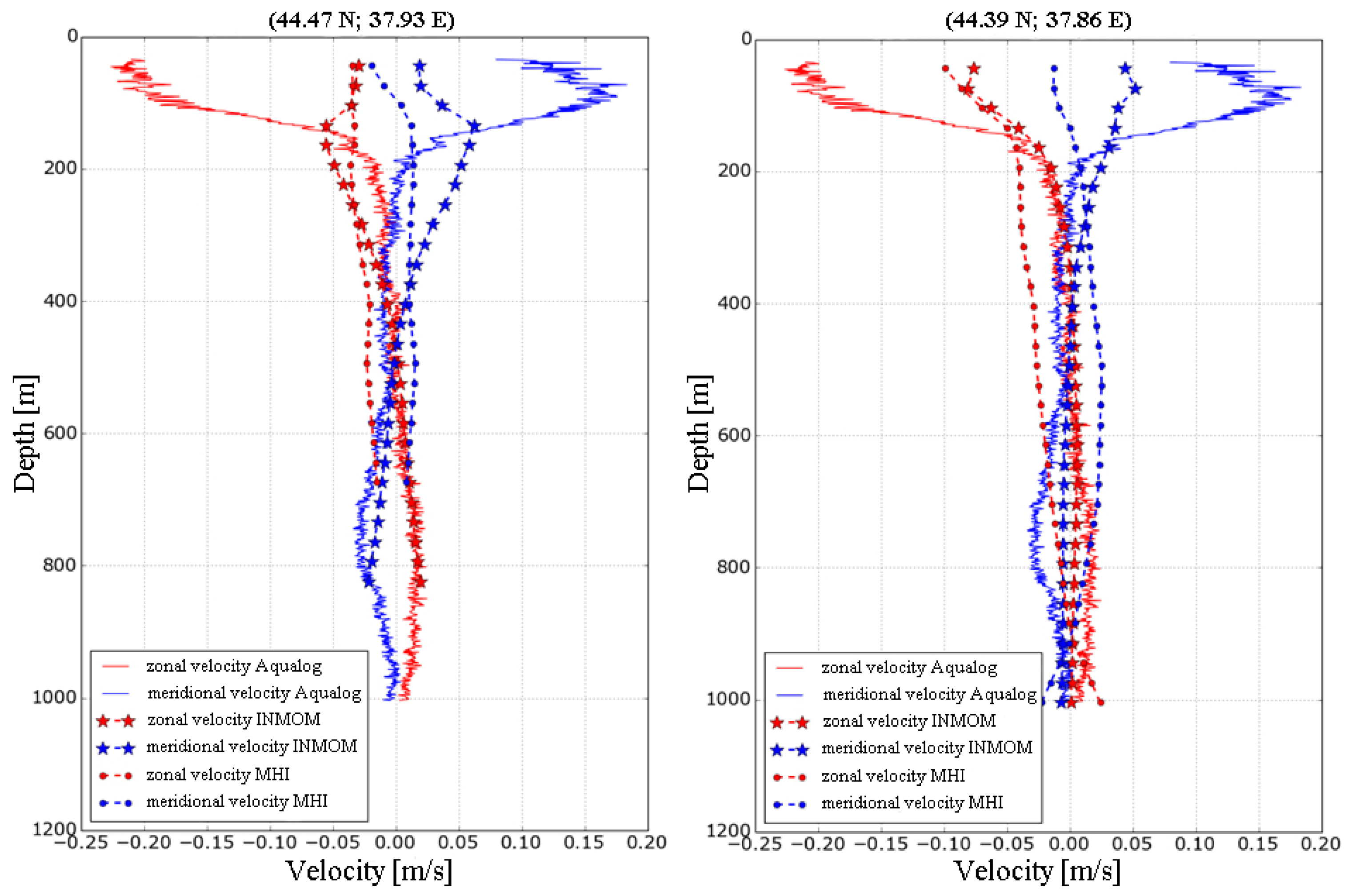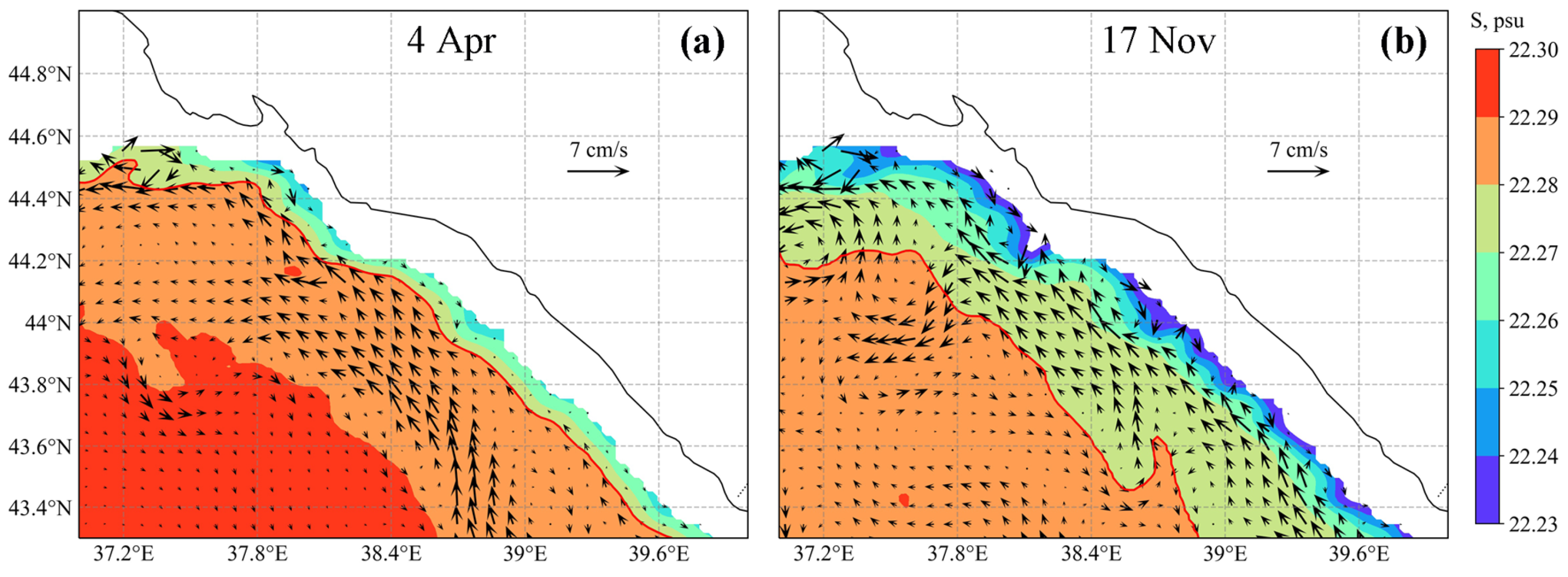Undercurrents in the Northeastern Black Sea Detected on the Basis of Multi-Model Experiments and Observations
Abstract
:1. Introduction
2. Data and Methods
2.1. MHI Eddy-Resolving Model
2.2. INMOM Sigma-Coordinate Ocean Model
2.3. NEMO Model
2.4. INMIO Eddy-Resolving Model
2.5. Experiment and Validation Setup
3. Comparison with Observational Data
3.1. Model–Observation Root Mean Square Errors
3.2. Sea Circulation Structure
3.3. Deep-Water Circulation off the North Caucasian Coast
4. Discussion and Conclusions
Author Contributions
Funding
Data Availability Statement
Acknowledgments
Conflicts of Interest
References
- Cromwell, T.; Montgomery, R.B.; Stroup, E.D. Equatorial undercurrent in the Pacific Ocean revealed by new methods. Science 1954, 119, 648–649. [Google Scholar] [CrossRef]
- Reid, J.L. Evidence of a South Equatorial Counter Current in the Atlantic Ocean in July l963. Nature 1964, 203, 182. [Google Scholar] [CrossRef]
- Beal, L.M.; Bryden, H.L. Observations of an Agulhas Undercurrent. Deep-Sea Res. 1997, 44, 1715–1724. [Google Scholar] [CrossRef]
- Yoon, J.H.; Philander, S.G.H. The Generation of Coastal Undercurrents. J. Oceanogr. Soc. Jpn. 1982, 38, 215–224. [Google Scholar] [CrossRef]
- Hill, A.E. Buoyancy effects in coastal and shelf seas. In The Sea; Brink, K.H., Robinson, A.R., Eds.; John Wiley & Sons: New York, NY, USA, 1998; Volume 10. [Google Scholar]
- Sarkisyan, A.S.; Ivanov, V.F. Joint effect of baroclinicity and bottom relief as an important factor in the dynamics of sea currents. Investiya Acad. Sci. USSR Atmos. Ocean. Sci. 1971, 7, 173–188. [Google Scholar]
- Clarke, A.J. Theoretical Understanding of Eastern Ocean Boundary Poleward Undercurrents. In Poleward Flows Along Eastern Ocean Boundaries. Coastal and Estuarine Studies; Neshyba, S., Mooers, C.N.K., Smith, R.L., Barber, R.T., Eds.; Springer: New York, NY, USA, 1989; Volume 34. [Google Scholar] [CrossRef]
- Francis, P.A.; Jithin, A.K.; Chatterjee, A.; Mukherjee, A.; Shankar, D.; Vinayachandran, P.N.; Ramakrishna, S.S. Structure and dynamics of undercurrents in the western boundary current of the Bay of Bengal. Ocean Dyn. 2020, 70, 387–404. [Google Scholar] [CrossRef]
- Bulgakov, S.N.; Korotaev, G.K.; Whitehead, J.A. The role of buoyancy-driven flows in the formation of large-scale circulation and stratification of the Black Sea waters. Parts 1, 2 (in Russian). Izv. Atmos. Ocean. Phys. 1996, 32, 548–564. [Google Scholar]
- Petrenko, L.A.; Kushnir, V.M. Climatic bottom currents in the Black Sea. In Ecological Safety of Coastal and Shelf Zones and Comprehensive Use of Shelf Resources; MHI: Sevastopol, Russia, 2006; pp. 477–486. (In Russian) [Google Scholar]
- Demyshev, S.G.; Ivanov, V.A.; Markova, N.V. Analysis of the Black Sea climatic fields below the main pycnocline obtained on the basis of assimilation of the archival data on temperature and salinity in the numerical hydrodynamic model. Phys. Oceanogr. 2009, 19, 1–12. [Google Scholar] [CrossRef]
- Arkhipkin, V.S.; Kosarev, A.N.; Gippius, F.N.; Migali, D.I. Seasonal variability of the climatic fields of temperature, salinity and circulation of the Black and Caspian seas. Mosc. Univ. Bull. Ser. 5 Geogr. 2013, 5, 33–44. (In Russian) [Google Scholar]
- Ostrovskii, A.G.; Zatsepin, A.G.; Soloviev, V.A.; Tsibulsky, A.L.; Shvoev, D.A. Autonomous system for vertical profiling of the marine environment at a moored station. Oceanology 2013, 53, 233–242. [Google Scholar] [CrossRef]
- Lukyanova, A.N.; Bagaev, A.V.; Plastun, T.V.; Markova, N.V.; Zalesny, V.B.; Ivanov, V.A. The Black Sea Deep-Water Circulation Research by Results of Numerical Modelling and In-Situ Data: INM RAS Model Numerical Experiment. Ecol. Saf. Coast. Shelf Zones Sea 2016, 3, 9–14. (In Russian) [Google Scholar]
- Klyuvitkin, A.A.; Ostrovskii, A.G.; Lisitzin, A.P.; Konovalov, S.K. The Energy Spectrum of the Current Velocity in the Deep Part of the Black Sea. Dokl. Earth Sc. 2019, 488, 1222–1226. [Google Scholar] [CrossRef]
- Korotaev, G.; Oguz, T.; Riser, S. Intermediate and deep currents of the Black Sea obtained from autonomous profiling floats. Deep-Sea Res. II 2006, 53, 1901–1910. [Google Scholar] [CrossRef]
- Gerasimova, S.V.; Lemeshko, E.E. Estimation of deep-water current velocities based on ARGO data. Monit. Syst. Environ. 2011, 15, 187–196. (In Russian) [Google Scholar]
- Demyshev, S.G.; Dymova, O.A.; Markova, N.V.; Piotukh, V.B. Numerical Experiments on Modeling of the Black Sea Deep Currents. Phys. Oceanogr. 2016, 2, 34–45. [Google Scholar] [CrossRef] [Green Version]
- Argo Program Homepage. Available online: http://www.argo.net (accessed on 26 June 2021).
- Ivanov, V.A.; Belokopytov, V.N. Oceanography of the Black Sea; ECOSY-Gidrofizika: Sevastopol, Russia, 2013; p. 210. [Google Scholar]
- Bank of Oceanographic Data of Marine Hydrophysical Institute. Available online: http://bod-mhi.ru (accessed on 26 June 2021).
- Demyshev, S.G. A numerical model of online forecasting Black Sea currents. Izv. Atmos. Ocean. Phys. 2012, 48, 120–132. [Google Scholar] [CrossRef]
- Roache, P.J. Computational Fluid Dynamics; Hermosa Publs.: Albuquerque, NM, USA, 1976. [Google Scholar]
- Harten, A. High resolution schemes for hyperbolic conservation laws. J. Comp. Phys. 1983, 49, 357–393. [Google Scholar] [CrossRef] [Green Version]
- Mellor, G.L.; Yamada, T. Development of a turbulence closure model for geophysical fluid problems. Rev. Geophys. 1982, 20, 851–875. [Google Scholar] [CrossRef] [Green Version]
- Marchuk, G.I.; Rusakov, A.S.; Zalesny, V.B.; Diansky, N.A. Splitting Numerical Technique with Application to the High Resolution Simulation of the Indian Ocean Circulation. Pure Appl. Geophys. 2005, 162, 1407–1429. [Google Scholar] [CrossRef]
- Diansky, N.A.; Fomin, V.V.; Zhokhova, N.V.; Korshenko, A.N. Simulations of currents and pollution transport in the coastal waters of Big Sochi. Izv. Atmos. Ocean. Phys. 2013, 49, 611–621. [Google Scholar] [CrossRef]
- Pacanowski, R.C.; Philander, S.G.H. Parameterization of Vertical Mixing in Numerical Models of Tropical Oceans. J. Phys. Oceanogr. 1981, 11, 1443–1451. [Google Scholar] [CrossRef]
- Lorenc, A.C.; Bell, R.S.; Macpherson, B. The Meteorological Office analysis correction data assimilation scheme. Q. J. R. Meteor. Soc. 1991, 117, 59–89. [Google Scholar] [CrossRef]
- Madec, G.; Bourdallé-Badie, R.; Chanut, J.; Clementi, E.; Coward, A.; Ethé, C.; Iovino, D.; Lea, D.; Lévy, C.; Lovato, T.; et al. NEMO Ocean Engine; IPSL: Guyancourt, France, 2019. [Google Scholar] [CrossRef]
- Mizyuk, A.I.; Korotaev, G.K.; Grigoriev, A.V.; Puzina, O.S.; Lishaev, P.N. Long-Term Variability of Thermohaline Characteristics of the Azov Sea Based on the Numerical Eddy-Resolving Model. Phys. Oceanogr. 2019, 26, 438–450. [Google Scholar] [CrossRef] [Green Version]
- Ibrayev, R.A.; Khabeev, R.N.; Ushakov, K.V. Eddy-resolving 1/10° model of the World Ocean. Izv. Atmos. Ocean. Phys. 2012, 48, 37–46. [Google Scholar] [CrossRef]
- Ushakov, K.V.; Ibrayev, R.A. Assessment of mean world ocean meridional heat transport characteristics by a high-resolution model. Russ. J. Earth Sci. 2018, 18, ES1004. [Google Scholar] [CrossRef] [Green Version]
- Kalmykov, V.V.; Ibrayev, R.A. The overlapping algorithm for solving shallow water equations on massively-parallel architectures with distributed memory. Vestnik UGATU 2013, 17, 252–259. (In Russian) [Google Scholar]
- Zalesak, S.T. Fully multidimensional flux-corrected transport algorithms for fluids. J. Comp. Phys. 1979, 31, 335–362. [Google Scholar] [CrossRef]
- Munk, W.H.; Anderson, E.R. Notes on a theory of the thermocline. J. Mar. Res. 1948, 7, 276–295. [Google Scholar]
- Kalmykov, V.V.; Ibrayev, R.A.; Kaurkin, M.N.; Ushakov, K.V. Compact Modeling Framework v3.0 for high-resolution global ocean–ice–atmosphere models. Geosci. Model Dev. 2018, 11, 3983–3997. [Google Scholar] [CrossRef] [Green Version]
- Mamayev, O.I. Temperature-Salinity Analysis of World Ocean Waters; Elsevier Science: Amsterdam, The Netherlands, 1975; p. 373. [Google Scholar]
- Large, W.G.; Pond, S. Open Ocean Momentum Flux Measurements in Moderate to Strong Winds. J. Phys. Oceanogr. 1981, 11, 324–336. [Google Scholar] [CrossRef] [Green Version]
- Brydon, D.; Sun, S.; Bleck, R. A new approximation of the equation of state for seawater, suitable for numerical ocean models. J. Geophys. Res. Ocean. 1999, 104, 1537–1540. [Google Scholar] [CrossRef]
- Griffies, S.M.; Biastoch, A.; Böning, C.; Bryan, F.; Danabasoglu, G.; Chassignet, E.P.; England, M.H.; Gerdes, R.; Haak, H.; Hallberg, R.W.; et al. Coordinated Ocean-ice Reference Experiments (COREs). Ocean Model. 2009, 26, 1–46. [Google Scholar] [CrossRef]
- Tenth Report of the Joint Panel on Oceanographic Tables and Standards; Technical Report, UNESCO Technical Papers in Marine Science 36; UNESCO: Paris, France, 1981.
- McDougall, T.J.; Jackett, D.R.; Wright, D.G.; Feistel, R. Accurate and Computationally Efficient Algorithms for Potential Temperature and Density of Seawater. J. Atmos. Ocean. Technol. 2003, 20, 730–741. [Google Scholar] [CrossRef]
- NonHydrostatic SKIRON/Eta Modelling System. Available online: https://forecast.uoa.gr/en/forecast-maps/skiron (accessed on 26 June 2021).
- EMODnet Digital Terrain Model. Available online: http://portal.emodnet-bathymetry.eu (accessed on 26 June 2021).
- General Bathymetric Chart of the Oceans (GEBCO). Available online: http://www.gebco.net (accessed on 26 June 2021).
- Belokopytov, V.N. Thermohaline and Hydrological-Acoustic Structure of the Black Sea Waters. Ph.D. Thesis, MHI NANU, Sevastopol, Russia, 2004. [Google Scholar]
- Markova, N.V.; Bagaev, A.V. The Black Sea deep current velocities estimated from the data of Argo profiling floats. Phys. Oceanogr. 2016, 3, 23–35. [Google Scholar] [CrossRef] [Green Version]
- List of Internal Metrics for the MERSEA-GODAE Global Ocean: Specification for Implementation; Technical Report, MERSEA IP; Mercator Ocean: Ramonville Saint-Agne, France, 2006.
- Miladinova, S.; Stips, A.; Garcia-Gorriz, E.; Macias Moy, D. Black Sea thermohaline properties: Long-term trends and variations. J. Geophys. Res. Oceans 2017, 122, 5624–5644. [Google Scholar] [CrossRef] [PubMed]
- Korshenko, E.A.; Diansky, N.A.; Fomin, V.V. Reconstruction of the Black Sea deep-water circulation using inmom and comparison of the results with the Argo buoys data. Phys. Oceanogr. 2019, 26, 202–213. [Google Scholar] [CrossRef] [Green Version]
- Markova, N.V.; Dymova, O.A.; Demyshev, S.G. Numerical Simulations of the Black Sea Hydrophysical Fields Below the Main Pycnocline: Validation by ARGO Data. In Physical and Mathematical Modeling of Earth and Environment Processes (2018); Karev, V., Klimov, D., Pokazeev, K., Eds.; Springer: Cham, Switzerland, 2019; pp. 15–21. [Google Scholar]
- Sandstrom, J.W.; Helland-Hansen, B. Uber die Berechnung von Meeresstromungen (About the calculation of ocean currents). Rep. Nor. Fish. Mar. Investig. 1903, 2, 43. [Google Scholar]
- Zubov, N.N.; Mamayev, O.I. A Dynamic Method for Calculating Elements of Sea Currents; Hydrometeopublish: Leningrad, Russia, 1956; p. 116. (In Russian) [Google Scholar]
- Milanova, M.; Peneva, E. Deep Black Sea Circulation Described by Argo Profiling Floats; Annual of Sofia University St. Kliment Ohridski, Faculty of Physics: Sofia, Bulgaria, 2016; p. 12. [Google Scholar]
- Poulain, P.M.; Menna, M.; Zu, Z. Geostrophic Currents in the Mediterranean and Black Seas Derived from Argo Float Profiles; ARGO-ITALY: Sgonico, Italy, 2016. [Google Scholar] [CrossRef]









| Model | Vertical Axis | Grid Type | Resolution | Vertical Mixing | Horizontal Mixing | Equation of State | Bulk Formulae |
|---|---|---|---|---|---|---|---|
| MHI | 27 z-levels | C | 1.6 km | [25] | biharmonic | [38] | SKIRON and [39] |
| INMOM | 20 -levels | C | 1 km | [28] | 2nd and 4th order | [40] | [41] |
| NEMO | 35 z-levels | C | 4.6 km | k- | biharmonic | [42] | [41] |
| INMIO | 51 z-levels | B | 1.5 km | [36] | biharmonic | [43] | [41] |
| Temperature RMSE, °C | Salinity RMSE, ‰ | |||||||
|---|---|---|---|---|---|---|---|---|
| Depth, m | MHI | INMOM | NEMO | INMIO | MHI | INMOM | NEMO | INMIO |
| 0–5 | 0.861 | 0.602 | 1.642 | 1.811 | 0.524 | 0.16 | 0.502 | 0.794 |
| 5–30 | 1.815 | 0.436 | 2.499 | 2.971 | 0.205 | 0.149 | 0.440 | 0.436 |
| 30–100 | 0.631 | 0.292 | 0.488 | 2.201 | 0.443 | 0.487 | 0.607 | 0.546 |
| 100–300 | 0.113 | 0.08 | 0.410 | 0.208 | 0.263 | 0.202 | 0.299 | 0.294 |
| 300–800 | 0.047 | 0.052 | 0.017 | 0.039 | 0.087 | 0.067 | 0.085 | 0.084 |
| 800–1500 | 0.03 | 0.125 | 0.013 | 0.109 | 0.009 | 0.008 | 0.009 | 0.013 |
Publisher’s Note: MDPI stays neutral with regard to jurisdictional claims in published maps and institutional affiliations. |
© 2021 by the authors. Licensee MDPI, Basel, Switzerland. This article is an open access article distributed under the terms and conditions of the Creative Commons Attribution (CC BY) license (https://creativecommons.org/licenses/by/4.0/).
Share and Cite
Demyshev, S.G.; Dymova, O.A.; Markova, N.V.; Korshenko, E.A.; Senderov, M.V.; Turko, N.A.; Ushakov, K.V. Undercurrents in the Northeastern Black Sea Detected on the Basis of Multi-Model Experiments and Observations. J. Mar. Sci. Eng. 2021, 9, 933. https://doi.org/10.3390/jmse9090933
Demyshev SG, Dymova OA, Markova NV, Korshenko EA, Senderov MV, Turko NA, Ushakov KV. Undercurrents in the Northeastern Black Sea Detected on the Basis of Multi-Model Experiments and Observations. Journal of Marine Science and Engineering. 2021; 9(9):933. https://doi.org/10.3390/jmse9090933
Chicago/Turabian StyleDemyshev, Sergey G., Olga A. Dymova, Natalia V. Markova, Evgenia A. Korshenko, Maksim V. Senderov, Nikita A. Turko, and Konstantin V. Ushakov. 2021. "Undercurrents in the Northeastern Black Sea Detected on the Basis of Multi-Model Experiments and Observations" Journal of Marine Science and Engineering 9, no. 9: 933. https://doi.org/10.3390/jmse9090933
APA StyleDemyshev, S. G., Dymova, O. A., Markova, N. V., Korshenko, E. A., Senderov, M. V., Turko, N. A., & Ushakov, K. V. (2021). Undercurrents in the Northeastern Black Sea Detected on the Basis of Multi-Model Experiments and Observations. Journal of Marine Science and Engineering, 9(9), 933. https://doi.org/10.3390/jmse9090933







